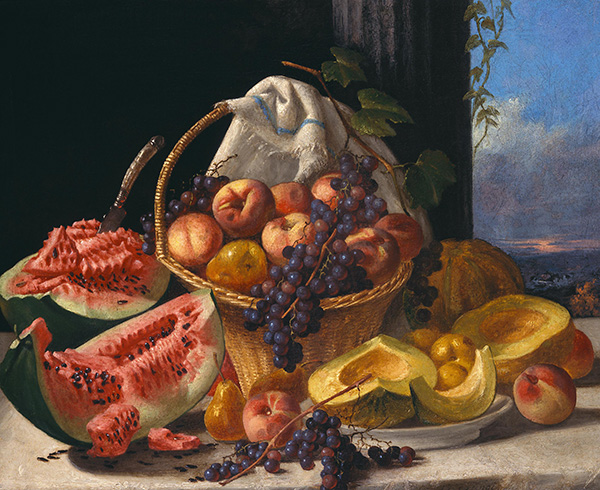Thanksgiving Week 2022: John F. Francis Still Life
I don’t usually attend a large buffet-style Thanksgiving dinner, but I always observe the underlying reason for Thanksgiving: being grateful. Among the many things I am grateful for—and there are a lot of them—is the opportunity to work with and write about art. I am thankful for art in general.
In the food aspect of the holiday, I present a work of art that really is not far off from what one might see at a huge Thanksgiving feast: tons of food. After the Civil War (1861–1865), the U.S. went through a period now sometimes referred to as the American Renaissance (1876–1917). It was a time of massive westward expansion and settlement, booming industry, burgeoning cities, and the advent of corporate America. There was also a flourishing of the arts unlike any time previously experienced in America. Many still-life paintings at the time paid tribute to the bounty of the American harvest.
 |
| John F. Francis (1808–1886, U.S.), Still Life with Fruit. Oil on canvas, 23 ¼" x 50" (59 x 76 cm). © 2022 Butler Institute of American Art, Youngstown, OH. (BIAA-281) |
Still Life with Fruit is emblematic of the differences between the Peale family still-life style and that of John F. Francis. Delicately colored with a painterly surface, Francis's still-life paintings are more complex, often incorporating a variety of objects that are not necessarily connected in the composition. The size and number of objects reflects the sentiment of abundance in the American continent. Another departure from Peale still-life works is the inclusion of the landscape background.
In American painting of the 1600s and 1700s, flowers and fruit were the province of botanical artists. The subjects were treated as scientific illustration. In the first two decades of the 1800s, the Peale family artists of Philadelphia, Pennsylvania, almost single-handedly established still life as an accepted subject matter for art.
Chief among the Peale artists were James (1749–1831) and Sarah Miriam (1800–1885), who produced still-life paintings of simple fruit arrangements, usually on a shallow ledge, representing little more than what they were. Such work appealed to the inherent American love of simple, unadorned realism in painting. As the century wore on, that simplicity was abandoned in favor of an exuberant exaltation of the bounty of the land.
Francis played an important part in elevating the status of still-life painting with middle-class American art patrons during the mid-1800s. Born in Philadelphia, Francis was very much influenced by the Peale painters. Primarily self-taught, he began his painting career as an itinerant portrait painter, traveling as far afield as Washington, DC, and Ohio. He began to exhibit in Philadelphia in the 1840s and 1850s.
Starting in the late 1840s, Daguerreotype photo portraits became popular, putting a crimp in the demand for painted portraits. By 1858, Francis had abandoned portraiture in favor of still life. Like the Peale painters, Francis incorporated the mannerisms of Dutch Baroque still-life painting, particularly the lavish "banquet piece" format that featured a table loaded with a bounty of food and drink.
View more bountiful John F. Francis still-life paintings in my post form 2017.
Correlations to Davis programs: Explorations in Art 2E Grade 1: 1.5; Explorations in Art 2E Grade 4: 6.8; Explorations in Art 2E Grade 5: 2.1, 2.2; Explorations in Art 2E Grade 6: 1.8; Experience Art 1E: 2.2 pp. 82-83; The Visual Experience 4E: 4.9; Discovering Drawing 3E: Chapter 3; Discovering Art History 4E: 2.1


Comments